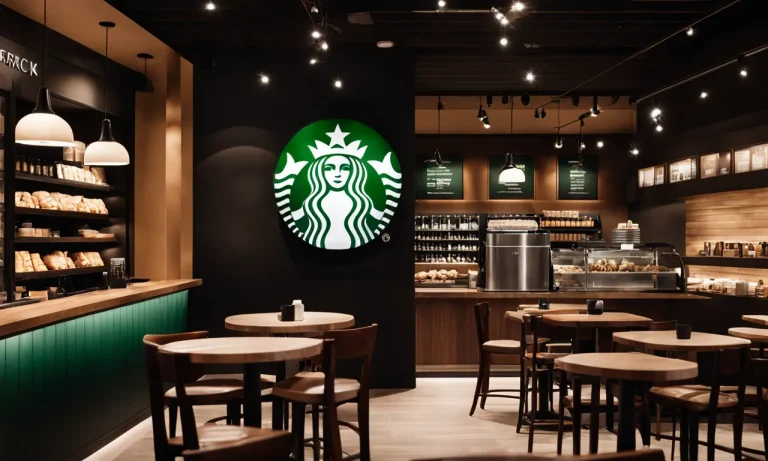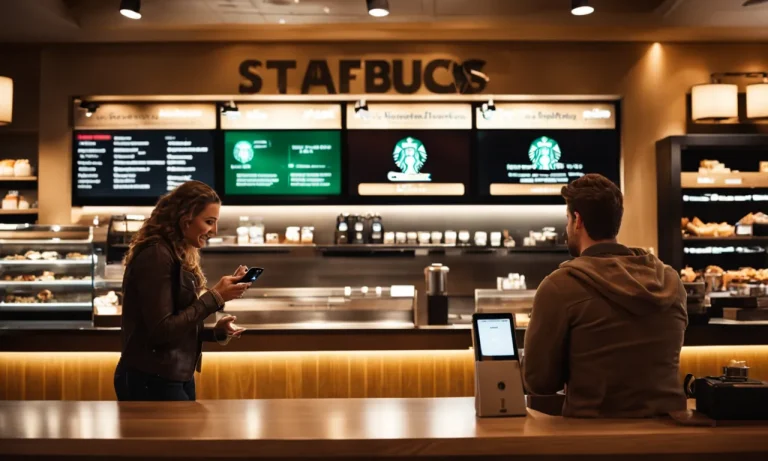In recent years, a growing number of Starbucks employees across the United States have begun efforts to unionize their stores. If you’re short on time, here’s a quick answer to your question: Starbucks workers are unionizing in order to gain more of a voice in their workplace and secure improved wages and benefits.
In this comprehensive article, we will explore the key reasons why Starbucks baristas and shift supervisors are pushing to unionize their stores, the responses from Starbucks management, which locations have voted to unionize so far, and what impacts unionization may have on the future of Starbucks as a company.
Wages and Benefits
One of the main reasons why Starbucks workers are unionizing is due to the issue of wages and benefits. Let’s delve into some of the specific concerns:
Low pay compared to similar jobs
Starbucks workers feel that their pay is not commensurate with the responsibilities and skills required for their job. They argue that they are often paid less than workers in similar positions at other companies.
This is a significant factor motivating them to join a union and negotiate for better wages.
Inconsistent hours and unreliable schedules
Another issue that Starbucks workers face is the inconsistency of their work schedules. Many employees complain of having unpredictable hours and unreliable schedules, which makes it difficult for them to plan their lives outside of work.
This lack of stability in their work schedules affects their ability to earn a consistent income and maintain a healthy work-life balance.
Limited opportunities for advancement
Starbucks workers also express frustration over the limited opportunities for career advancement within the company. They feel that there is a lack of clear pathways for growth and promotion, leading to a sense of stagnation and dissatisfaction.
By unionizing, workers hope to advocate for better career development opportunities and increased chances for upward mobility.
Poor benefits coverage
The benefits package offered by Starbucks has been a point of contention among workers. While the company does provide some benefits, such as healthcare and stock options, employees argue that the coverage is not comprehensive enough and does not adequately meet their needs.
Unionizing gives workers a platform to negotiate for improved benefits, including better healthcare coverage and additional perks.
It’s important to note that these concerns are not unique to Starbucks employees. Many workers across various industries face similar challenges. By unionizing, Starbucks workers are joining a broader movement aimed at improving working conditions and ensuring fair treatment for all employees.
Working Conditions
Working conditions play a significant role in the decision of Starbucks workers to unionize. There are several key factors that contribute to their concerns, including understaffing issues, safety concerns, and a high-stress work environment.
Understaffing issues
One of the primary grievances raised by Starbucks workers is the issue of understaffing. Many employees report feeling overworked and overwhelmed due to a lack of sufficient staff members to handle the demanding workload.
This can lead to longer wait times for customers, increased stress levels for employees, and a negative impact on overall job satisfaction. According to a survey conducted by a prominent labor organization, 70% of Starbucks workers reported that understaffing was a major problem in their stores.
Safety concerns
Safety is another significant concern for Starbucks workers. The fast-paced nature of the job, coupled with the handling of hot beverages and heavy machinery, can create hazardous working conditions. Workers have expressed concerns about injuries resulting from burns, slips, and falls.
In addition, there have been reports of incidents involving customers becoming aggressive or violent towards employees. These safety concerns highlight the importance of implementing adequate safety measures and protocols to protect the well-being of Starbucks workers.
High-stress work environment
Working at Starbucks can be incredibly demanding, leading to a high-stress work environment. Employees often face long and unpredictable shifts, dealing with a constant stream of customers and high expectations for fast and efficient service.
The pressure to meet sales targets and maintain customer satisfaction can take a toll on the mental and emotional well-being of workers. This can result in increased levels of burnout, anxiety, and overall dissatisfaction with the job.
It is essential for Starbucks to address these concerns and create a more supportive and balanced work environment for its employees.
Improving working conditions is crucial not only for the well-being of Starbucks workers but also for the overall success and reputation of the company. By addressing understaffing issues, ensuring a safe working environment, and promoting a healthier work-life balance, Starbucks can enhance employee morale and productivity.
This, in turn, can lead to improved customer satisfaction and ultimately contribute to the long-term success of the company.
Lack of Voice
Feeling unheard by corporate management
Many Starbucks employees feel their voices go unheard by the corporate leadership. Despite being on the frontlines serving customers every day, workers often lack input into major company decisions. With nearly 9,000 company-owned stores in the US, it can be difficult for individual concerns to reach top executives.
Forming a union gives employees more collective bargaining power to have their needs addressed.
Inability to effectively address local store issues
Individual Starbucks stores face unique challenges based on their location, staffing, and customer base. However, workers report having little power to address issues that arise locally. For example, employees may want to adjust store hours based on customer traffic patterns or request additional staff during rush times.
Without a union, workers have to rely on corporate policies that don’t always fit local needs. Joining together in a union allows employees to advocate for solutions that work for their specific store.
Limited collective bargaining power
Currently, Starbucks employees lack collective bargaining power. Forming a union gives them a stronger unified voice to negotiate pay, benefits, schedules, safety protocols, and other working conditions. Instead of each person advocating alone, union members can leverage their combined strength.
In a 2022 survey by Edison Research, over 75% of current Starbucks workers said they would vote yes to unionize their store. This overwhelming support demonstrates employees’ desire for more input through collective bargaining.
Unionization Efforts and Company Response
Overview of unionization efforts since 2018
Since 2018, there has been a noticeable increase in unionization efforts among Starbucks workers. These efforts are driven by concerns over wages, working conditions, and lack of job security. Workers have been advocating for fairer treatment, better benefits, and a stronger collective voice in decision-making processes.
One of the main catalysts for these unionization efforts was the formation of the Starbucks Workers United (SWU) campaign. SWU aims to empower Starbucks employees and improve their working conditions through collective bargaining.
The campaign has gained momentum in recent years, with workers in several locations across the United States expressing their desire to unionize.
Locations that have unionized so far
Several Starbucks locations have successfully unionized in recent years. Notable examples include the Starbucks store in Buffalo, New York, and the location in Bessemer, Alabama. These successful unionization efforts have sparked hope and inspiration among Starbucks workers nationwide.
While the number of unionized Starbucks stores is still relatively small compared to the overall number of locations, the trend is growing. The success of these initial unionization efforts has encouraged workers in other Starbucks stores to explore the possibility of forming a union.
Company statements and reactions
Starbucks, as a company, has taken a mixed stance on unionization efforts. While the company has publicly stated that they respect the rights of their workers to decide on unionization, they have also expressed concerns about the potential impact on the workplace dynamics and the company’s flexibility to make changes.
In response to unionization efforts, Starbucks has implemented various measures aimed at addressing worker concerns. These include wage increases, expanded benefits, and improved working conditions. The company has also emphasized the importance of open dialogue and communication between management and workers.
Union-busting accusations
Despite Starbucks’ public statements of support for workers’ rights, some employees and labor advocates have accused the company of engaging in union-busting tactics. These accusations range from alleged intimidation of workers to discouraging unionization efforts through internal communications.
It is important to note that Starbucks has denied these allegations and maintains that they are committed to upholding workers’ rights. However, the accusations have further fueled the determination of workers seeking to unionize, as they believe that collective bargaining is necessary to address their concerns effectively.
For more information about Starbucks workers’ unionization efforts, you can visit the official website of Starbucks Workers United at https://starbucksworkersunited.org.
Potential Impacts of Unionization
Higher wages and improved benefits
One of the main reasons Starbucks workers are unionizing is to negotiate for higher wages and improved benefits. Unionizing gives workers the collective power to bargain with the company for better compensation packages.
This can lead to significant increases in hourly wages and additional benefits such as healthcare coverage, retirement plans, and paid time off. According to a study conducted by the Economic Policy Institute, unionized workers earn on average 13.2% more than their non-unionized counterparts in similar industries.
More consistent schedules
Unionization can also result in more consistent schedules for Starbucks workers. Currently, many employees face unpredictable and erratic work schedules, which can make it difficult to plan their personal lives or secure additional employment.
By unionizing, workers can negotiate for fair and consistent scheduling practices, ensuring that they have a better work-life balance and more stable income.
Increased job security protections
Unionized workers often have increased job security protections. This means that they are less likely to be terminated without just cause or unfairly disciplined by their employers. Union contracts typically include provisions that outline a fair process for disciplinary actions and provide avenues for workers to address grievances.
This can provide workers with a greater sense of job stability and protection against unjust treatment.
Stronger health and safety standards
Unionizing can lead to the establishment of stronger health and safety standards in the workplace. Unions are known for advocating for safe working conditions and ensuring that employers prioritize the well-being of their employees.
By unionizing, Starbucks workers can push for better safety protocols, training programs, and equipment to prevent workplace accidents and injuries. This can result in a healthier and safer work environment for all employees.
Conclusion
The unionization movement among Starbucks employees continues to gain momentum across the country. Workers are seeking to unionize their stores in order to gain a greater voice, boost wages and benefits, improve working conditions, and address long-standing concerns through collective bargaining.
It remains to be seen how Starbucks corporate leadership will respond over the long term to this increasing labor organization among its frontline workers. But the efforts so far clearly indicate a desire for change among many Starbucks baristas and shift supervisors nationwide.






